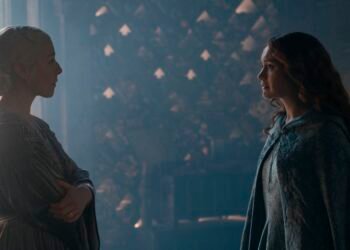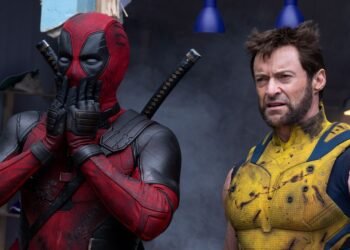This review was originally published in conjunction with the premiere of Guillermo del Toro’s Pinocchio at the 2022 BFI London Film Festival. It has been updated and republished for the film’s Netflix debut.
From the opening frames of Guillermo del Toro’s Pinocchio, it’s obvious this is a del Toro film — and not just because of the possessive title. He’s a filmmaker with a visual signature as strong as Tim Burton or Wes Anderson, albeit one that hasn’t hardened so formally, and still has the ability to adapt and to surprise. With Pinocchio, del Toro turns, as both those directors have, to stop-motion animation, which allows him to retain the texture of his live-action work while controlling the look of every single element in the frame.
But the film’s success is about more than looks. What’s surprising about Pinocchio is how personal to del Toro it feels, despite him sharing director credit with Mark Gustafson, despite its shoot overlapping with that of Nightmare Alley, despite the work of its creation being done by teams of artisans spread across three continents. This Netflix animated film might be the most del Toro movie since Pan’s Labyrinth; it’s certainly one of the best since then, and as distinctive as any of his English-language work.
What it isn’t is anything like the timeless 1940 Walt Disney film, or its recent, lifeless remake, or either of the two Roberto Benigni-starring, live-action Italian takes, or any of the dozens of other attempts to adapt Carlo Collodi’s 1883 book. Extraordinarily, it is the first to be done in stop-motion, and thus the first in which Pinocchio, the wooden puppet boy who comes to life, is played by an actual puppet. Beyond this, del Toro (who co-wrote the script, as well as the lyrics for a handful of songs) takes a few key passages and themes from Collodi, discards even more than Disney did, and moves the story to the mid-20th century. He expands it to take in many of his own key motifs, especially from the horrific fairy tales The Devil’s Backbone and Pan’s Labyrinth: Europe between the wars, the specter of Fascism, the terror of childhood, the land of the dead, and the meeting point of the monstrous, the human, and the sublime.

Image: Netflix
In this telling, Geppetto the humble woodcarver (David Bradley) has a beloved human son, Carlo, who dies in a World War I bombing. Years later, he creates Pinocchio (Gregory Mann), not out of whimsy, but in a quite wild and frightening bout of drunken grief with more than a hint of Frankenstein to it. Pinocchio is hewn from a pine tree grown from a cone that Carlo had collected, and where Sebastian J. Cricket (Ewan McGregor), a pompous insect raconteur, had set up home. Cricket witnesses an austere, angelic Wood Sprite (played by Tilda Swinton, who else) bring Pinocchio to life. But he still crawls back into his home in the wooden boy’s heart to live.
This Pinocchio is quizzical, rash, and impulsive — a far cry from the dutiful Carlo. Hours after coming to life, he is wheeling around Geppetto’s workshop in a crazed whirligig, his spindly limbs jerking and spinning, smashing everything he touches. It’s delightful and also slightly threatening. Pinocchio is raw and unfinished, with nails and twigs still sticking out of him, ungainly movements, and chaotic behavior. But unlike most tellers of this tale, del Toro has no interest in smoothing these imperfections away.
Pinocchio challenges every symbol and situation del Toro throws at him. “Why do people love him and not me?” he asks, looking at a wooden Christ in the local church. Count Volpe (Christoph Waltz), an avaricious circus ringmaster, and the Podestà (Ron Perlman), a Fascist official, both try to trick the credulous puppet into serving their interests. But where the wooden boy goes, anarchy tends to follow: into the presence of Il Duce himself, Mussolini, or into the belly of a giant, monstrous dogfish, or into a sepulchral afterlife where rabbits with exposed ribcages play cards.

Image: Netflix
There’s a lot going on here. It’s a messy, episodic scheme for a film, and the filmmakers don’t hit every target they aim for. This is not a kids’ movie, although it sometimes has the mannerisms of one (and adventurous kids may get as much out of it as anyone else, if not more). In the later stages, elements of satire, parable, creature feature, dark fairy tale, and sweet sentimentality rub up against each other, not always harmoniously. But many of its threads are pure pleasure, such as the rivalry between Pinocchio and Count Volpe’s monkey puppeteer Sprezzatura. There’s more to this cunning, grotesque animal than meets the eye (and that’s before you realize its wordless screeches and yelps were supplied by no less an actor than Cate Blanchett).
Pinocchio is also a feast for the senses, even by del Toro’s gluttonous standards. There’s a rich, melodic, romantic score by Alexandre Desplat (The Shape of Water). There is exquisite voice work, especially from Bradley (the veteran Game of Thrones and Harry Potter character actor) as the irascible Geppetto, and from McGregor, who nails all the biggest laugh lines and whose voiceover does so much to leaven and bind together this sometimes awkward movie.
And there is the animation, produced by ShadowMachine in studios in the U.S., U.K. and Mexico. It is an incredible spectacle of a sort that CG and even hand-drawn animation cannot hope to achieve: rich, tactile, somehow intimate, even in its grandest moments. The puppets, as you might expect from the creator of Pan’s Labyrinth’s Pale Man, are variously eerie, uncanny, grotesque, adorable, and sad creations, and always memorable. The screen is always saturated with light, color, and detail, and the animators stage amazing coups of action and scale. But what stays with you are the gentlest gestures: the way Geppetto trails his long, careworn fingers across a blanket, or the way Pinocchio’s expression changes in the wood grain around his eyes.
There’s no doubt that this is, technically and artistically, one of the great works of stop motion, a rarefied and quixotic art form. Within its stubbornly practical world of rubber and clay, paper and paint, joints and wires and levers, this is as ambitious an undertaking as Avatar. But del Toro’s greatest achievement is not to let all the artistry overwhelm the art. It’s an unruly, wild, and tender film that sometimes gets lost but, by the end, finds its way to a very moving state of grace.
Guillermo del Toro’s Pinocchio is streaming on Netflix now.
























































